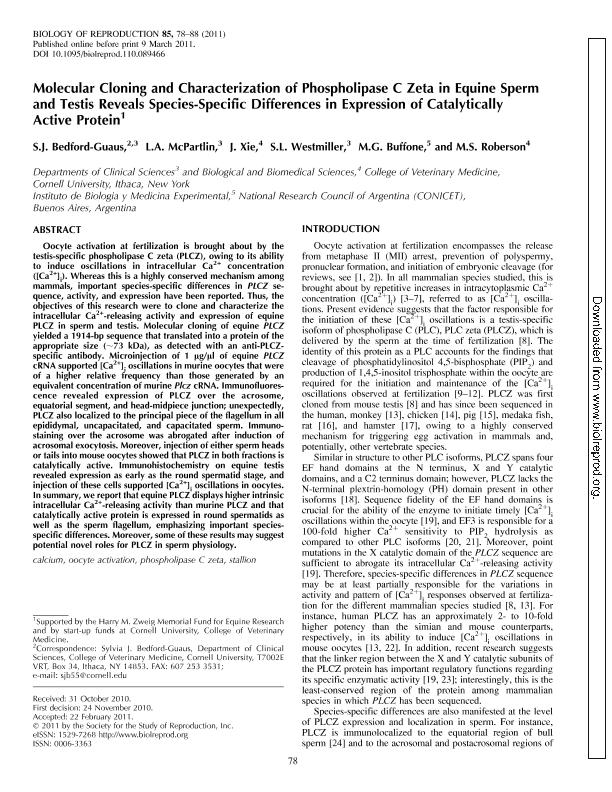Artículo
Molecular cloning and characterization of Phospholipase C Zeta in equine sperm and testis reveals species-specific differences in expression of catalytically active protein
Bedford Guaus, Sylvia J.; Mc Partlin, L. A. ; Xie, J. ; Westmiller, S. L. ; Buffone, Mariano Gabriel ; Roberson, M. S.
; Roberson, M. S.
 ; Roberson, M. S.
; Roberson, M. S.
Fecha de publicación:
07/2011
Editorial:
Society For The Study Of Reproduction
Revista:
Biology Of Reproduction
ISSN:
0006-3363
e-ISSN:
1529-7268
Idioma:
Inglés
Tipo de recurso:
Artículo publicado
Clasificación temática:
Resumen
Oocyte activation at fertilization is brought about by the testis-specific phospholipase C zeta (PLCZ), owing to its ability to induce oscillations in intracellular Ca(2+) concentration ([Ca(2+)](i)). Whereas this is a highly conserved mechanism among mammals, important species-specific differences in PLCZ sequence, activity, and expression have been reported. Thus, the objectives of this research were to clone and characterize the intracellular Ca(2+)-releasing activity and expression of equine PLCZ in sperm and testis. Molecular cloning of equine PLCZ yielded a 1914-bp sequence that translated into a protein of the appropriate size (~73 kDa), as detected with an anti-PLCZ-specific antibody. Microinjection of 1 μg/μl of equine PLCZ cRNA supported [Ca(2+)](i) oscillations in murine oocytes that were of a higher relative frequency than those generated by an equivalent concentration of murine Plcz cRNA. Immunofluorescence revealed expression of PLCZ over the acrosome, equatorial segment, and head-midpiece junction; unexpectedly, PLCZ also localized to the principal piece of the flagellum in all epididymal, uncapacitated, and capacitated sperm. Immunostaining over the acrosome was abrogated after induction of acrosomal exocytosis. Moreover, injection of either sperm heads or tails into mouse oocytes showed that PLCZ in both fractions is catalytically active. Immunohistochemistry on equine testis revealed expression as early as the round spermatid stage, and injection of these cells supported [Ca(2+)](i) oscillations in oocytes. In summary, we report that equine PLCZ displays higher intrinsic intracellular Ca(2+)-releasing activity than murine PLCZ and that catalytically active protein is expressed in round spermatids as well as the sperm flagellum, emphasizing important species-specific differences. Moreover, some of these results may suggest potential novel roles for PLCZ in sperm physiology.
Palabras clave:
Sperm
,
Fertilization
,
Oocyte
,
Plczeta
Archivos asociados
Licencia
Identificadores
Colecciones
Articulos(IBYME)
Articulos de INST.DE BIOLOGIA Y MEDICINA EXPERIMENTAL (I)
Articulos de INST.DE BIOLOGIA Y MEDICINA EXPERIMENTAL (I)
Citación
Bedford Guaus, Sylvia J.; Mc Partlin, L. A. ; Xie, J. ; Westmiller, S. L. ; Buffone, Mariano Gabriel; et al.; Molecular cloning and characterization of Phospholipase C Zeta in equine sperm and testis reveals species-specific differences in expression of catalytically active protein; Society For The Study Of Reproduction; Biology Of Reproduction; 85; 1; 7-2011; 78-88
Compartir



